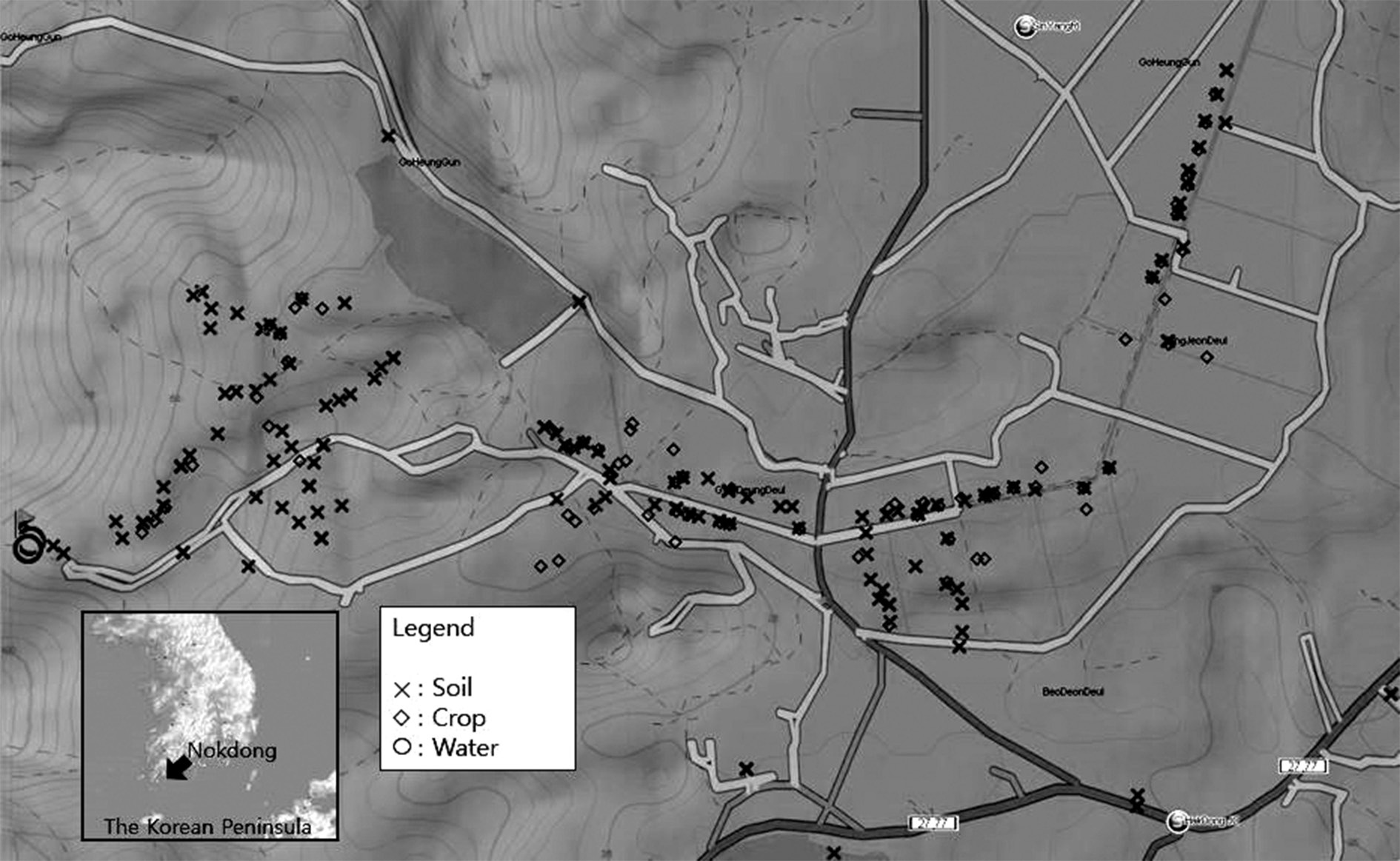



A risk assessment of environmental media was performed for the inhabitants in the area of the abandoned Nokdong metal mine. Soil, groundwater, and crop samples were collected from September to October 2008 around the mine. After pretreatment of these samples, metal concentrations were measured, and a risk assessment was performed using the Korean soil-contamination risk assessment guidelines. Lead (Pb) and arsenic (As) intake rates were the highest for inhalation of soil dust. The cancer risks from ingestion of As-contaminated groundwater, inhalation of As-, Cd-, and Pb-contaminated soils, and contact of As-contaminated soils exceeded the acceptable risk. The sum of all carcinogenic risks was 9.29 × 10-3. The non-carcinogenic risk was highest for ingestion of As-contaminated water (11.0), followed, in descending order, by inhalation of Hg-contaminated soil and ingestion of Pb-contaminated water. Most of the risks were associated with As, Cd, Pb, and Hg contamination, and therefore, these metals were considered to be potential toxic carcinogens and non-carcinogens for humans in this area. In this study, the non-carcinogenic risks of ingestion of contaminated water or crops, as well as those associated with the inhalation of soil dust were observed.
Metal mines were actively developed in the early twentieth century in Korea; however, most of these mines were closed and abandoned without proper management in the 1970s, because of economic conditions and the exhaustion of ore reserves [1]. Currently, about 940 abandoned metal mines exist in Korea, and primary investigations for soil contamination by metals in the mines have been performed. Recently, additional precise investigations for approximately 300 mines have been performed over the three-year period from 2007 to 2009. These investigations have focused on soil contamination and have reported that the soils have been contaminated by arsenic (As) and heavy metals. Toxic metal contaminations in soils in the vicinity of Korean abandoned metal mines and the health risks for the inhabitants have been reported elsewhere [1-8].
For risk assessment for human health, soil investigation is not enough, because most of the risk comes from the ingestion of contaminated crops and water [1,3,4]. The risks for humans in the vicinity of several metal mines have been assessed (Table 1). The main pathways for human contamination are through their ingestion of water and crops. Rice and water ingestion were determined to be the primary pathways for As or Cd exposure and posed both carcinogenic and non-carcinogenic health risks to farmers in the Dongil, Okdong, Dongjung, Dokok, Hwacheon, Myungbong, Songchun, and Songcheon mine areas. Carcinogenic and non-carcinogenic health risks from As ingestion with soil were observed only in the Songchun mine area. Carcinogenic health risk by dermal contact with As-contaminated water was observed only in the Songcheon mine area.
The abandoned Nokdong metal mine, which had never been assessed for risk, was selected for an assessment of risk to inhabitants in the vicinity of the mine. The purpose of this study was to 1) investigate the metal contamination levels of soil, groundwater and crops; 2) estimate the daily intake of metals; 3) estimate carcinogenic and non-carcinogenic risks by various metal pathways; and 4) assess the risks for farmers in the vicinity of the abandoned Nokdong metal mine.
2.1. Investigation of Metal Contamination
The Nokdong Au-Ag mine is located in Goheung province of Jeonnam, South Korea. This mine had been developed to exploit gold and silver in 1950s, and the total amount of gold extracted was just 300 g. After closure of the mine, tailings and waste rock were left behind without proper environmental treatment. The mining wastes have been rinsed down into paddy fields by water and wind action.
Soil, groundwater, and crop samples were collected from September to October 2008 in the vicinity of the mine. Topsoil (0–15 cm depth) and subsoil (15–30 cm depth) samples were collected from agricultural fields. Contaminant analysis of soil was performed according to the Korean Standard Test (KST) methods for soils [9]. All soil samples were air-dried before further pretreatment for contaminant analysis other than for Hg. For the determination of Cd, Pb, Cu, and As, dried soils were sieved to 10 mesh (<2 mm). Ten grams of sieved soil was extracted with 50 mL of 0.1 N (for analysis of Cd, Pb, and Cu) or 1 N (for analysis of As) hydrochloric acid solution for 1 hr on a reciprocating shaker with 100 rpm at 30℃. The extracted solution was filtrated through 5B filter paper. For Zn analysis, dried soils were pulverized and sieved through 100 mesh (<0.15 mm). Three grams of sieved soil was digested with 28 mL of 3:1 HCl/HNO3 solution (aqua regia) for 1 hr at 70℃. The extracted or digested solution was filtrated through 5B filter paper, and the concentrations of metals were then measured by inductively coupled plasma-atomic emission spectrometry (2100DV; Perkin-Elmer, Waltham, MA, USA). Sampled soil was used in a Direct Mercury Analyzer (DMA-80; Milestone, Shelton, CT, USA) for Hg analysis.
Groundwater used as drinking water was sampled around the mine area. The sample was filtered through a 0.45-μm membrane, acidified with concentrated HNO3, and finally the metal (As, Cd, Pb, and Hg) concentrations in the water sample were measured using inductively coupled plasma-mass spectrometry (ICP-MS).
Rice and soybean samples were collected from farmlands and paddy fields around the mine. Collected samples were rinsed with deionized water to remove any soil particles on the surface. The edible parts of the samples were then air-dried at room temperature and pulverized. Zero point five grams of each sample was digested with 5 mL of concentrated nitric acid (65%), 5 mL of H2O, and 1 mL of H2O2 in a microwave digestion system. After digestion, the solution was filtered, and metals of Cd and Pb, which were regulated components in crops in Korea, were measured by ICP-MS.
[Table 1.] Mines where carcinogenic and non-carcinogenic risks have been reported
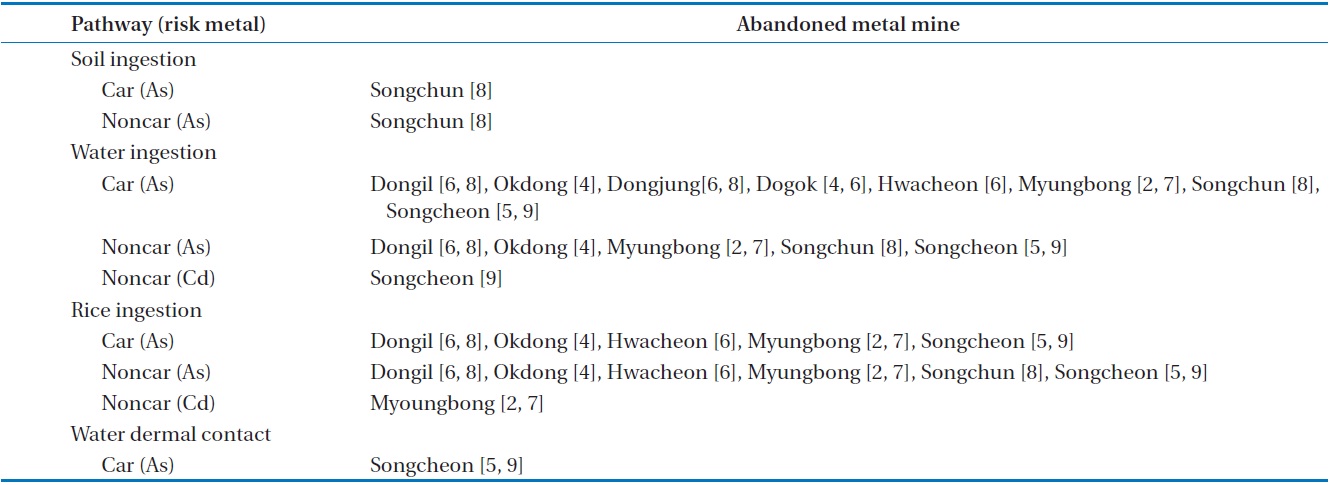
Mines where carcinogenic and non-carcinogenic risks have been reported
The purposes of risk assessment are to provide information to decision-makers about the consequences of possible actions, the source treatment and disposal options, the remediation of contaminated sites, and the clean-up standards. The risk assessment consisted of four main analyses: hazard identification, exposure assessment, toxicity (dose-response) assessment, and risk characterization [10]. Risk is defined as the probability of suffering harm or loss. Hazard is the source of risk, that is, the intrinsic capability of a chemical to cause harm. A chemical does not represent a risk unless exposure has occurred or the possibility of future exposure exists.
Hazard identification aims to investigate what chemicals are present at a site, their concentrations, and their spatial distribution. In this stage, the contaminant concentrations in media, such as air, groundwater, surface water, soils, and sediments are examined. In the second stage, the exposure of the populations potentially at risk is estimated, considering contaminant sources (such as tailings, drainage ponds, contaminated soils, stream water, and groundwater), their spatial distribution, and the available environmental pathways. In the third stage, the toxicity is estimated, considering adverse effects and exposure levels of carcinogenic and non-carcinogenic chemicals. The slope factor (SF, a carcinogen potency factor) and the acceptable daily intake or reference dose (RfD, a non-carcinogenic threshold) are two principal toxicity indices. In the final stage, the levels of cancer risk and hazard index are predicted by integrating the results of the exposure assessment and the toxicity assessment.
To identify hazards, soils, groundwater used for drinking, and crop samples were collected from the vicinity of the mine. The concentrations of metals in those samples were measured, and exposure concentrations in these media were estimated following the Korean soil-contamination risk assessment guidelines [11,12]. In the guidelines, crop concentration can be estimated using soil concentration and bioconcentration factor; however, in this study, directly measured crop concentrations were used.
Fig. 1 shows the exposure pathways of contaminated soils to human as expressed in the Korean guidelines [11]. Five pathways (contaminated soils, crop ingestion through harvested crops, groundwater ingestion as drinking water, soil ingestion, and dermal contact with soil and dust inhalation through outdoor and indoor air) are suggested for metal exposure in the Korean guidelines. In exposure assessment, the average daily dose was calculated by summing the intakes of toxic metals through the suggested pathways. The intake of metals with exposure can be quantitatively calculated using the formula in Table 2. The exposure factors and the input parameters to calculate the intake for Korean farmers are summarized in Table 3.
[Table 2.] Equations of average daily intake with different exposure pathways (unit: mg/kg·day)
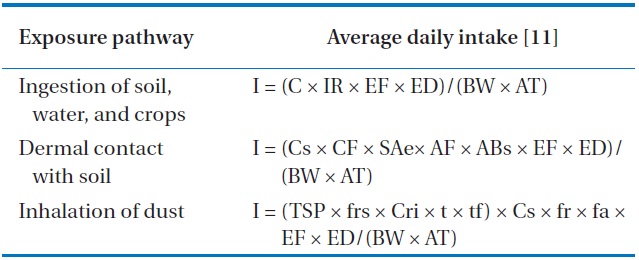
Equations of average daily intake with different exposure pathways (unit: mg/kg·day)
2.5. Toxicity (Dose-Response) Assessment
Dose-response relationships for carcinogens are reported as lifetime incidence of cancer (i.e., probability) versus dose. The slope, known as SF, represents the carcinogenic potency of the chemical. Unlike carcinogens, there is a threshold effect for non-carcinogens. In other words, below a specific dose, no adverse health effect occurs in exposed populations. This threshold is defined as the RfD. Carcinogenic and non-carcinogenic risks for contaminants were estimated using SF and RfD, respectively, as given in the Korean guidelines [11]. As and Pb are classified as carcinogenic metals, and the other metals are classified as non-carcinogens.
Risk characterization is quantitatively expressed by carcinogenic risk and non-carcinogenic risk. Carcinogenic risk may be defined as the average daily intake (calculated in the exposure assessment) multiplied by the carcinogenic SF (selected by the toxicity assessment) and can be calculated using the following formula:
Carcinogenic risk = I (average daily intake) × SF
where the values of SF for As and Pb were as given in the Korean guidelines. The estimated value is the probability of an individual developing any type of cancer from lifetime exposure to carcinogenic chemicals. The total carcinogenic risk equals the sum by exposure route to carcinogenic risks from all individual substances. The acceptable or tolerable total risk for regulatory purposes is in the range of 10-6 to 10-4 [11].
Non-carcinogenic risk is normally characterized in terms of a hazard index (HI). This index is defined as the ratio of the average daily intake (I) from exposure (calculated in the exposure assessment) to the reference concentration (selected by the toxicity assessment) and can be calculated as follows:
HI (non-carcinogenic risk) = I / RfD
Where the values of RfD for metals were as given in the Korean guidelines. For exposure to multiple non-carcinogens, the HI scores for all non-carcinogens are summed to provide the final measure of the risk for non-carcinogenic adverse effects. If the sum of HIs exceeds 1.0, this implies that the contaminants had non-carcinogenic adverse effects.
[Table 3.] Parameters and factors used for an adult Korean farmer [11, 12]
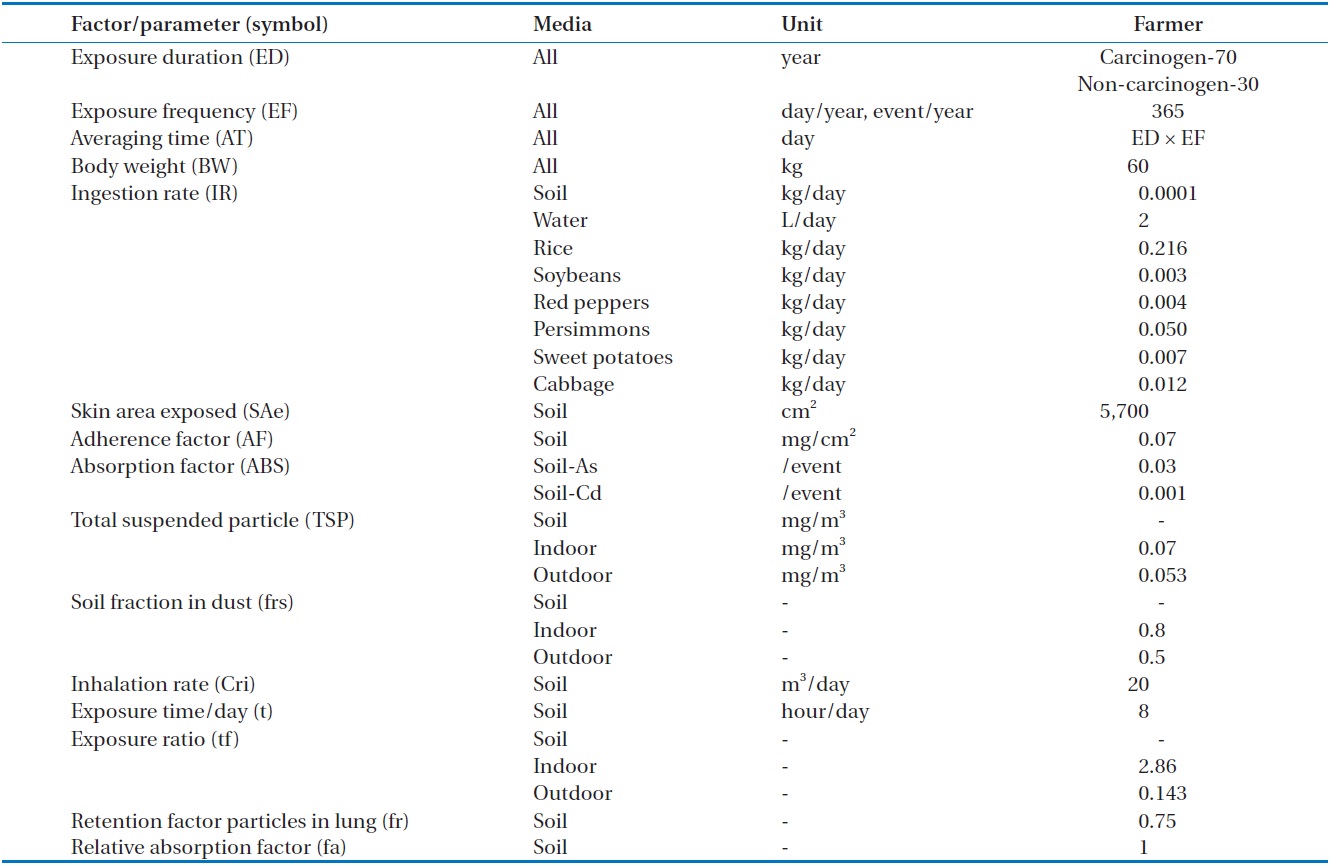
Parameters and factors used for an adult Korean farmer [11, 12]
[Table 4.] Concentrations of metals in media around the abandoned Nokdong metal mine

Concentrations of metals in media around the abandoned Nokdong metal mine
One hundred twelve soils (80 from paddies and 32 from farmland soils), two groundwater sources, and 76 crops (74 rice and 2 soybeans) were sampled from the vicinity of the mine, and the sampling points are expressed in Fig. 2. The arithmetic mean concentrations of As, Cd, Cu, Pb, Zn, and Hg in these media are shown in Table 4. All metals measured were detected in soils, and the Zn concentration was the highest. Average metal concentrations were below the Korean warning standards for soil [13]. As, Cd, and Pb metals were detected in the groundwater. As and Cd concentrations were above the Korean drinking water standard, and Pb concentration was below the standard [14]. In crop samples, Cd and Pb were detected in rice, but the concentrations were comparatively lower than those in soil, and below the maximum
permissible concentration of the Korean food standards [15]. Cd was detected in soybeans, but the concentration was below the maximum permissible concentration of the Korean food standards [15].
Phytoextraction, also called phytoaccumulation, refers to the uptake and translocation of metal contaminants in soil by plant roots into the aboveground portions of the plants [16]. Simmons et al. [17] reported that As and Pb concentrations in plant tissues were directly proportional to those in the aqueous phase. Benzarti et al. [18] reported that phytoaccumulation of Cd, Zn, and Cu varied depending on the plant. Similar results were observed in this study. The Cd (0.014 mg/kg) and Pb (0.001 mg/kg) concentrations in rice in this area were higher than the concentrations in soybeans. Different metal concentrations were observed for each crop species.
Estimated daily metal intake rates from the various media are shown in Table 5 for an adult Korean farmer. The parameters and factors shown in Table 3, which are listed in the Korean guidelines [11], were used to estimate the daily intake rate. The daily intake rate of metals was the highest for Zn, followed, in descending order, by Pb, Cu, As, Cd, and Hg. The metal intake
[Table 5.] Daily intake of metals from each medium (unit: mg/kg·day)

Daily intake of metals from each medium (unit: mg/kg·day)
rate through the various pathways was the highest for inhalation of soil dust, followed in descending order by groundwater ingestion, soil ingestion, crop ingestion, and dermal contact with soil. The rate for crop ingestion was the highest in rice, followed by soybeans. Considering both metals and pathways, Zn intake through inhalation of soil dust was the highest. Arsenic (As) daily intake rate was the highest through inhalation of soil dust, followed by groundwater ingestion. Pb daily intake rate was the highest through inhalation of soil dust.
Estimated carcinogenic risks of metals from the various media are shown in Table 6. SFs (kg·day/mg) of As and Pb for ingestion of soil, water, and crops were given as 1.5 and 0.0085, respectively, in the Korean guidelines. The SF of As for soil contact was given as 61. The SFs of As, Cd, and Pb for soil inhalation were given as 0.015, 0.0063, and 0.042, respectively. The cancer risk of metals was the highest for As (5.21 × 10-3), followed in descending order by Pb and Cd. Cancer risk by pathway was the highest for groundwater ingestion, followed in descending order by soil inhalation, dermal contact with soil, soil ingestion and crop ingestion. Cancer risk from crop ingestion was for Pb in rice. Considering metals and pathways, cancer risk was highest from ingestion of As-contaminated water, followed by inhalation of Pb-contaminated soil and inhalation of As-contaminated soil.
Carcinogenic risk is the probability of an individual developing any type of cancer from lifetime exposure to carcinogenic chemicals. The acceptable or tolerable total risk for regulatory purposes is in the range of 10-6 to 10-4 [11]. Considering 10-5 as an acceptable risk, which means that one additional case in 100,000 people is acceptable, there was considerable carcinogenic risk from As, Pb, and Cd in this area. The cancer risks from ingestion of As-contaminated groundwater, inhalation of As-, Cd-, and Pb-contaminated soils, and contact of As-contaminated soils exceeded the acceptable risk. However, the risks from ingestion of crop and soil did not exceed the acceptable risk. The sum of all carcinogenic risks was 9.29 × 10-3. This value is equivalent to the probability that approximately nine cancers per 1,000 people will occur. Most of the risk was due to As and Pb contamination, and therefore, Pb and As were considered to be the principal carcinogens for humans in this area.
It has been reported that the inhabitants around the following mines have been exposed to carcinogenic health threats: Dongil, Okdong, and Hwacheon mines due to ingestion of As-contaminated
[Table 6.] Carcinogenic risk of metals
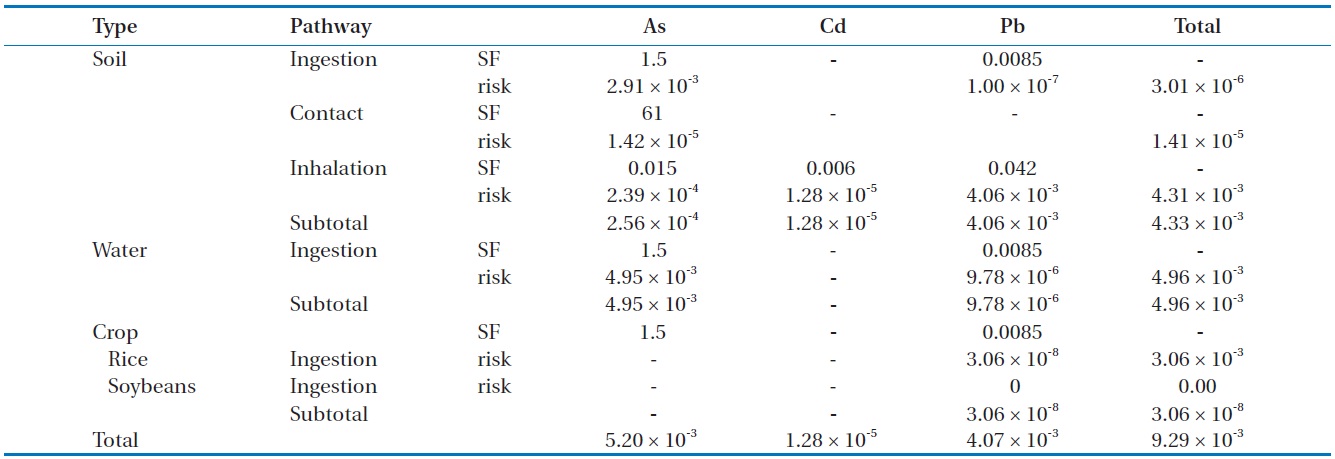
Carcinogenic risk of metals
[Table 7.] Non-carcinogenic risk of metals
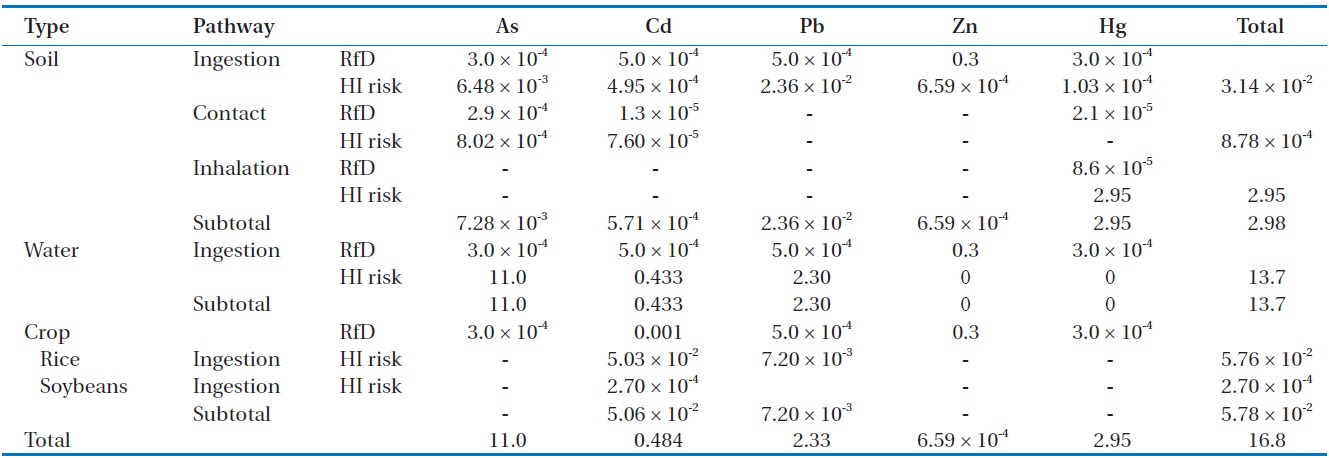
Non-carcinogenic risk of metals
water and soil [5]; Dongil, Dongjung, Myungbong, and Songchun mines due to ingestion of As-contaminated water [7]; Myungbong mine due to ingestion of As-contaminated rice [6]; Songchun mine due to ingestion of As-contaminated soil, water, and crops [8]; and Okdong and Hwacheonmines due to the ingestion of As-contaminated rice and water [4]. Carcinogenic risk in the Korean abandoned mine area by ingestion of contaminated soil, water, and crops has been reported as mentioned above; however, the risk of As and Pb contamination by inhalation of contaminated soil has not been reported up to now. In this study, the maximum permissible cancer risk was exceeded from the inhalation of As- and Pb-contaminated soil in abandoned Nokdong mine. The risk of inhalation of metal-contaminated soil should be considered in a carcinogenic risk assessment along with the ingestion of water and crops in abandoned mine areas.
Estimated non-carcinogenic risks of metals from the various media studied are shown in Table 7. The RfD values of As, Cd, Pb, Zn, and Hg for intake from soil, water, and crops were as given in the Korean guidelines. The non-carcinogenic risk (HI) of metals was the highest for As, with a value of 11.0, followed in descending order by Hg, Pb, Cd, and Zn. By pathway, the highest non-carcinogenic risk was in the ingestion of groundwater (13.73), followed in descending order by inhalation of soil dust, ingestion of crops, ingestion of soil and contact with soil. HI by crop and soil ingestion, and contact with soil was less than one. Considering metal and pathways, the risk was highest for ingestion of As-contaminated water (11.0), followed in descending order by inhalation of Hg-contaminated soil and ingestion of Pb-contaminated water. Most of the risk was due to As, Hg, and Pb contamination, and therefore, As, Hg, and Pb were considered to be the principal non-carcinogens for humans in this area.
The HI values for Cd and Zn for each pathway were less than one, and their sum was also less than one (Table 7). Therefore, the non-carcinogenic risk from Cd and Zn in this area is not substantial. However, the HI values for As, Pb, and Hg for all pathways were 11.0, 2.95, and 2.33, respectively. These values are higher than one, and their non-carcinogenic risks are high and substantial for the inhabitants in the vicinity of the abandoned Nokdong mine. The highest non-carcinogenic risk is in the ingestion of As-contaminated water, followed by ingestion of Pb-contaminated water and inhalation of Hg-contaminated soil in this area. However, the HI values for ingestion of crops and soil, and contact with soil were less than one.
A non-carcinogenic risk of As or Cd contamination in the area of the Koran abandoned mine by ingestion of water and crops has been reported as summarized in Table 1. In this study, non-carcinogenic risks of not only ingestion of contaminated water or crops, but also inhalation of soil dust were observed.
The metal intake rate was the highest for inhalation of soil dust, followed in descending order by groundwater ingestion, soil ingestion, crop ingestion, and soil contact. The cancer risks from ingestion of As-contaminated groundwater, inhalation of As-, Cd-, and Pb-contaminated soils, and contact of As-contaminated soils exceeded the acceptable risk. The sum of all carcinogenic risks was 9.29 × 10-3. The non-carcinogenic risk was highest for ingestion of As-contaminated water (11.0), followed in descending order by inhalation of Hg-contaminated soil and ingestion of Pb-contaminated water. Most of the risks were due to As, Cd, Pb, and Hg contamination, and therefore, these metals were considered to be the principal carcinogens or non-carcinogens for humans in this area. The inhalation of metal-contaminated soil should be considered to be an important factor for risk assessment, along with the ingestion of water and crops in abandoned mine areas.

![Suggested exposure pathways of contaminants in soils to humans [11].](http://oak.go.kr/repository/journal/12974/E1HGBK_2013_v18n4_221_f001.jpg)

![Parameters and factors used for an adult Korean farmer [11, 12]](http://oak.go.kr/repository/journal/12974/E1HGBK_2013_v18n4_221_T003.jpg)

